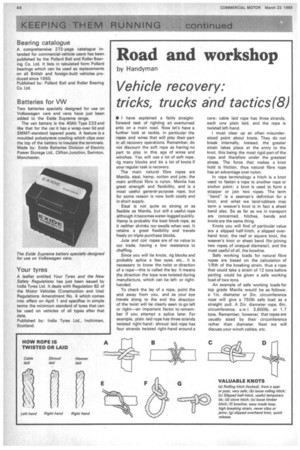Road and workshop
Page 46

If you've noticed an error in this article please click here to report it so we can fix it.
by Handyman
Vehicle recovery: tricks, trucks and tactics(8)
• I have explained a fairly straightforward task of righting an overturned artic on a main road. Now let's have a further look at tackle, in particular the ropes and wires that will play their part in all recovery operations. Remember, do not discount the soft rope as having no part to play in this age of wires and winches. You will use a lot of soft rope, rig many blocks and tie a lot of knots if your regular task is recovery.
The main natural fibre ropes are Manila, sisal, hemp, cotton and jute; the main artificial fibre is nylon. Manila has great strength and flexibility, and is a most useful general-purpose rope, but for some reason is now both costly and in short supply.
Sisal is not quite so strong or as flexible as Manila, but still a useful rape although it becomes water-logged quickly. Hemp is probably the best block rope, as it neither shrinks nor swells when wet. It retains a great flexibility and travels freely on triple-purchase blocks.
Jute and coir ropes are of no value to our trade, having a low resistance to chaffing.
Since you will tie knots, rig blocks and probably splice a few eyes, etc„ it is necessary to know the twist or direction of a rope—this is called the lay. it means the direction the tope was twisted during manufacture, which can be leftor righthanded.
To check the lay of a rope, point the end away from you, and as your eye travels along to the end the direction of the twist will be clearly seen to go left or right—an important factor to remember if you attempt a splice later. For example. plain laid rope has three strands twisted right-hand: shroud laid rope has four strands twisted right-hand around a core; cable laid rope has three strands, each one plain laid. and the rope is twisted left-hand.
I must clear up an often misunderstood point about knots. They do not break internally, instead, the greater strain takes place at the entry to the knot, this being the most rigid part of the rope and therefore under the greatest stress. The force that makes a knot hold is friction, thus natural fibre rope has an advantage over nylon.
In rope terminology a hitch is a knot used to fasten a rope to another rope or anchor point; a knot is used to form a stopper or join two ropes. The term -bendis a seaman's definition for a knot, and what we land-lubbers may term a weaver's knot is in fact a sheet bend also. So as far as we in transport are concerned, hitches, bends and knots are the same thing.
Knots you will find of particular value are a slipped half-hitch, a slipped overhand knot, the reef or square knot, the weaver's knot or sheet bend (for joining two ropes of unequal diameter}, and the most useful of all, the bowline.
Safe working loads for natural fibre ropes are based on the calculation of 1/6th of the breaking strain, thus a rope that could take a strain of 12 tons before parting could be given a safe working load of two tons.
An example of safe working loads for top grade Manila would be as follows: a 1in. diameter or 3in, circumference rope will give a 7501b safe load as a straight pull. A 2in. diameter rope, 6in. circumference, s.w.l. 3,800lb, or 1.7 tons. Remember, however, that ropes are usually sized by their circumference rather than diameter. Next we will discuss your winch cables, etc.












































































































